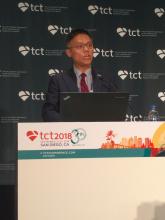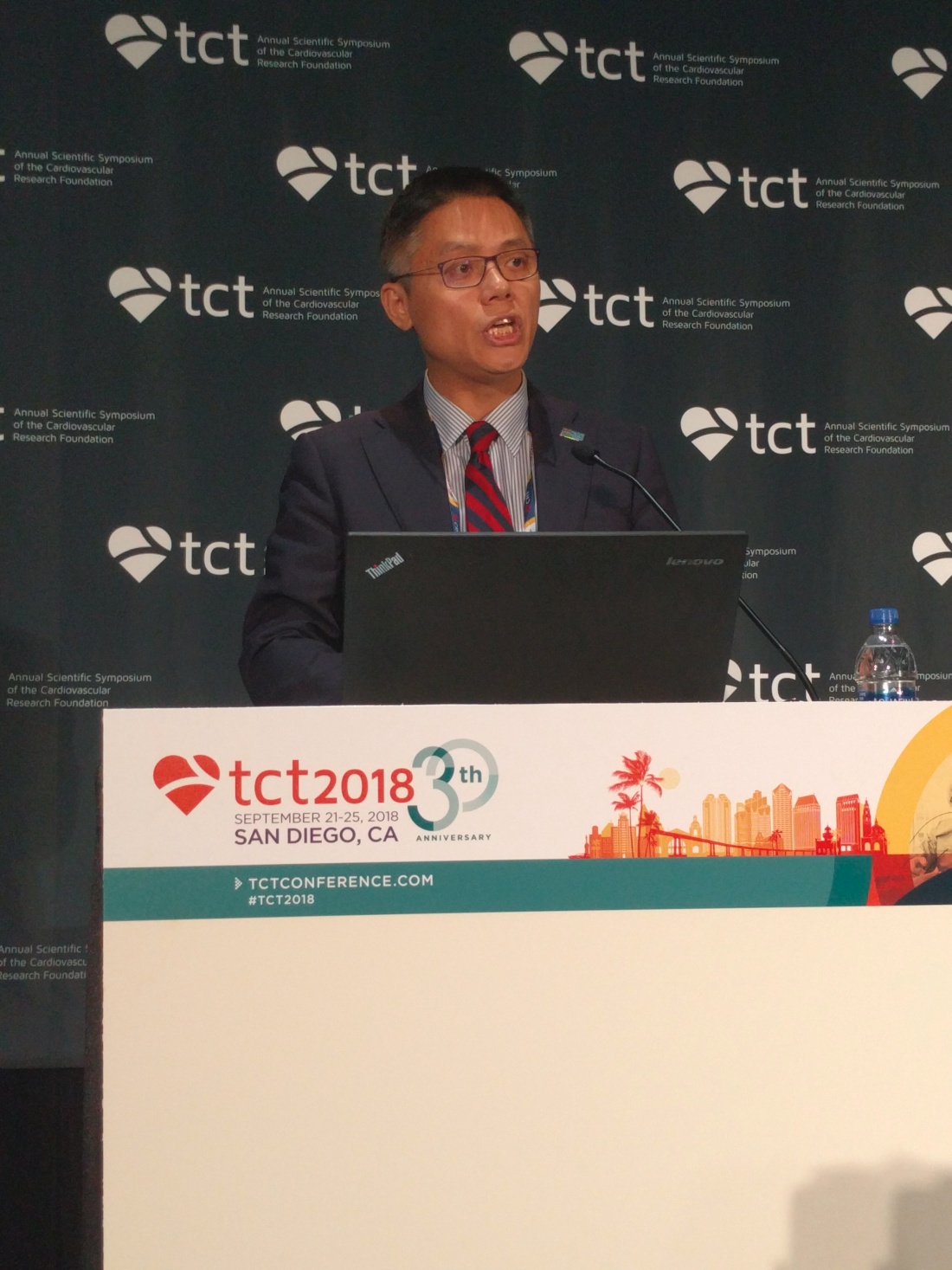User login
SAN DIEGO – An all-comers trial conducted in China confirms that intravascular ultrasound (IVUS)–guided implantation of drug-eluting stents (DES) resulted in better clinical outcomes than did angiography-guided procedures, Jun-Jie Zhang, MD, said in reporting results of the ULTIMATE trial at the Transcatheter Cardiovascular Therapeutics annual meeting.
The ULTIMATE trial is the latest in a line of evidence showing the utility of IVUS guidance, though uptake of the procedure is not high in the United States or Europe. Its broader focus also rounds out the findings of earlier studies, which focused on patients with more complex lesions.
“How can people continue to ignore the importance of imaging-guided stent optimization? Even with second-generation DES, the results are consistent across the studies. This is just another piece of irrefutable evidence,” said discussant Gary Mintz, MD.
That sentiment was generally echoed by the rest of the panel. John McB Hodgson, MD, a professor of medicine at MetroHealth Medical Center in Cleveland, also pointed out the consistency of the body of evidence supporting the use of imaging. The study also represented a variety of cases, and the angiography arm of the study showed that the procedure was performed to a high standard. “It shows that even with a good angiographic approach, IVUS still wins. I’m amazed that there’s still some resistance to image guidance,” said Dr. Hodgson.
In ULTIMATE, 1,448 all-comer patients were randomized to either IVUS-guided or angiography-guided DES implantation. Patients with a life-expectancy shorter than 12 months, who were intolerant of dual-antiplatelet therapy, or who had severe calcification needing rotational atherectomy were excluded.
The procedural time was longer in the IVUS group, at 61 min, compared with 45 min in the angiography group, and the contrast volume was higher, at 178 mL and 162 mL, respectively (P less than .001 for both). At 30 days, the incidence of target vessel failure (TVF) was 0.8% in the IVUS group and 1.9% in the angiographic group, though this difference did not reach statistical significance (P = .08). The trend did reach significance at 1 year, with failure occurring in 2.9% of IVUS patients and 5.4% of angiography patients (P = .019). The hazard ratio for TVF in the IVUS group was 0.53 (95% confidence interval, 0.312-0.901), for a relative risk reduction of 47%, reported Dr. Zhang of Nanjing (China) Medical University.
Patients also underwent a postprocedure IVUS assessment to determine whether the stent was deployed optimally or suboptimally. The criteria for optimal deployment included minimal lumen area in the stented segment at least 5.0 mm2, or 90% of the minimal lumen area at distal reference segment meeting that criteria; a less than 50% plaque burden at the 5 mm of vessel proximal or distal to the stent edge; and no edge dissection involving media greater than 3 mm in length.
More than half (53%) of patients in the IVUS group had optimal placement, and 47% did not. Significantly fewer (1.6%) of patients with optimal IVUS experienced TVF at 12 months, compared with 4.4% of the suboptimal group (HR, 0.35; 95% CI, 0.135-0.898). The results were published online simultaneously with the presentation in the Journal of the American College of Cardiology.
“I’m particularly impressed by the analysis of the optimal versus nonoptimal group. If you don’t use IVUS correctly, you don’t get a benefit. The ones who did not get optimal stenting were very similar to the angiographic group,” said Dr. Mintz, chief medical officer at the Cardiovascular Research Foundation, which sponsored the meeting.
ULTIMATE was funded by the National Science Foundation of China and several other research organizations. Dr. Zhang had no relevant disclosures. Dr. Mintz has received research support and/or consulting fees from Abbott Vascular, Boston Scientific, Volcano, and Infraredx. Dr. Hodgson has received research support and consulted for Volcano.
SAN DIEGO – An all-comers trial conducted in China confirms that intravascular ultrasound (IVUS)–guided implantation of drug-eluting stents (DES) resulted in better clinical outcomes than did angiography-guided procedures, Jun-Jie Zhang, MD, said in reporting results of the ULTIMATE trial at the Transcatheter Cardiovascular Therapeutics annual meeting.
The ULTIMATE trial is the latest in a line of evidence showing the utility of IVUS guidance, though uptake of the procedure is not high in the United States or Europe. Its broader focus also rounds out the findings of earlier studies, which focused on patients with more complex lesions.
“How can people continue to ignore the importance of imaging-guided stent optimization? Even with second-generation DES, the results are consistent across the studies. This is just another piece of irrefutable evidence,” said discussant Gary Mintz, MD.
That sentiment was generally echoed by the rest of the panel. John McB Hodgson, MD, a professor of medicine at MetroHealth Medical Center in Cleveland, also pointed out the consistency of the body of evidence supporting the use of imaging. The study also represented a variety of cases, and the angiography arm of the study showed that the procedure was performed to a high standard. “It shows that even with a good angiographic approach, IVUS still wins. I’m amazed that there’s still some resistance to image guidance,” said Dr. Hodgson.
In ULTIMATE, 1,448 all-comer patients were randomized to either IVUS-guided or angiography-guided DES implantation. Patients with a life-expectancy shorter than 12 months, who were intolerant of dual-antiplatelet therapy, or who had severe calcification needing rotational atherectomy were excluded.
The procedural time was longer in the IVUS group, at 61 min, compared with 45 min in the angiography group, and the contrast volume was higher, at 178 mL and 162 mL, respectively (P less than .001 for both). At 30 days, the incidence of target vessel failure (TVF) was 0.8% in the IVUS group and 1.9% in the angiographic group, though this difference did not reach statistical significance (P = .08). The trend did reach significance at 1 year, with failure occurring in 2.9% of IVUS patients and 5.4% of angiography patients (P = .019). The hazard ratio for TVF in the IVUS group was 0.53 (95% confidence interval, 0.312-0.901), for a relative risk reduction of 47%, reported Dr. Zhang of Nanjing (China) Medical University.
Patients also underwent a postprocedure IVUS assessment to determine whether the stent was deployed optimally or suboptimally. The criteria for optimal deployment included minimal lumen area in the stented segment at least 5.0 mm2, or 90% of the minimal lumen area at distal reference segment meeting that criteria; a less than 50% plaque burden at the 5 mm of vessel proximal or distal to the stent edge; and no edge dissection involving media greater than 3 mm in length.
More than half (53%) of patients in the IVUS group had optimal placement, and 47% did not. Significantly fewer (1.6%) of patients with optimal IVUS experienced TVF at 12 months, compared with 4.4% of the suboptimal group (HR, 0.35; 95% CI, 0.135-0.898). The results were published online simultaneously with the presentation in the Journal of the American College of Cardiology.
“I’m particularly impressed by the analysis of the optimal versus nonoptimal group. If you don’t use IVUS correctly, you don’t get a benefit. The ones who did not get optimal stenting were very similar to the angiographic group,” said Dr. Mintz, chief medical officer at the Cardiovascular Research Foundation, which sponsored the meeting.
ULTIMATE was funded by the National Science Foundation of China and several other research organizations. Dr. Zhang had no relevant disclosures. Dr. Mintz has received research support and/or consulting fees from Abbott Vascular, Boston Scientific, Volcano, and Infraredx. Dr. Hodgson has received research support and consulted for Volcano.
SAN DIEGO – An all-comers trial conducted in China confirms that intravascular ultrasound (IVUS)–guided implantation of drug-eluting stents (DES) resulted in better clinical outcomes than did angiography-guided procedures, Jun-Jie Zhang, MD, said in reporting results of the ULTIMATE trial at the Transcatheter Cardiovascular Therapeutics annual meeting.
The ULTIMATE trial is the latest in a line of evidence showing the utility of IVUS guidance, though uptake of the procedure is not high in the United States or Europe. Its broader focus also rounds out the findings of earlier studies, which focused on patients with more complex lesions.
“How can people continue to ignore the importance of imaging-guided stent optimization? Even with second-generation DES, the results are consistent across the studies. This is just another piece of irrefutable evidence,” said discussant Gary Mintz, MD.
That sentiment was generally echoed by the rest of the panel. John McB Hodgson, MD, a professor of medicine at MetroHealth Medical Center in Cleveland, also pointed out the consistency of the body of evidence supporting the use of imaging. The study also represented a variety of cases, and the angiography arm of the study showed that the procedure was performed to a high standard. “It shows that even with a good angiographic approach, IVUS still wins. I’m amazed that there’s still some resistance to image guidance,” said Dr. Hodgson.
In ULTIMATE, 1,448 all-comer patients were randomized to either IVUS-guided or angiography-guided DES implantation. Patients with a life-expectancy shorter than 12 months, who were intolerant of dual-antiplatelet therapy, or who had severe calcification needing rotational atherectomy were excluded.
The procedural time was longer in the IVUS group, at 61 min, compared with 45 min in the angiography group, and the contrast volume was higher, at 178 mL and 162 mL, respectively (P less than .001 for both). At 30 days, the incidence of target vessel failure (TVF) was 0.8% in the IVUS group and 1.9% in the angiographic group, though this difference did not reach statistical significance (P = .08). The trend did reach significance at 1 year, with failure occurring in 2.9% of IVUS patients and 5.4% of angiography patients (P = .019). The hazard ratio for TVF in the IVUS group was 0.53 (95% confidence interval, 0.312-0.901), for a relative risk reduction of 47%, reported Dr. Zhang of Nanjing (China) Medical University.
Patients also underwent a postprocedure IVUS assessment to determine whether the stent was deployed optimally or suboptimally. The criteria for optimal deployment included minimal lumen area in the stented segment at least 5.0 mm2, or 90% of the minimal lumen area at distal reference segment meeting that criteria; a less than 50% plaque burden at the 5 mm of vessel proximal or distal to the stent edge; and no edge dissection involving media greater than 3 mm in length.
More than half (53%) of patients in the IVUS group had optimal placement, and 47% did not. Significantly fewer (1.6%) of patients with optimal IVUS experienced TVF at 12 months, compared with 4.4% of the suboptimal group (HR, 0.35; 95% CI, 0.135-0.898). The results were published online simultaneously with the presentation in the Journal of the American College of Cardiology.
“I’m particularly impressed by the analysis of the optimal versus nonoptimal group. If you don’t use IVUS correctly, you don’t get a benefit. The ones who did not get optimal stenting were very similar to the angiographic group,” said Dr. Mintz, chief medical officer at the Cardiovascular Research Foundation, which sponsored the meeting.
ULTIMATE was funded by the National Science Foundation of China and several other research organizations. Dr. Zhang had no relevant disclosures. Dr. Mintz has received research support and/or consulting fees from Abbott Vascular, Boston Scientific, Volcano, and Infraredx. Dr. Hodgson has received research support and consulted for Volcano.
REPORTING FROM TCT 2018
Key clinical point:
Major finding: IVUS guidance reduced target vessel failure by 47%.
Study details: ULTIMATE, a randomized, controlled trial of 1,448 patients.
Disclosures: ULTIMATE was funded by the National Science Foundation of China and several other research organizations. Dr. Zhang had no relevant disclosures. Dr. Mintz has received research support from Abbott Vascular and Boston Scientific. He has been a consultant for Boston Scientific, Volcano, and Infraredx. Dr. Hodgson has received research support and consulted for Volcano.

